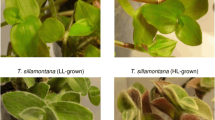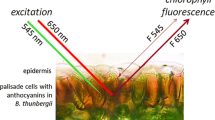Abstract
The temperature dependence of the rate of de-epoxidation of violaxanthin to zeaxanthin was determined in leaves of chilling-sensitive Gossypium hirsutum L. (cotton) and chilling-resistant Malva parviflora L. by measurements of the increase in absorbance at 505 nm (ΔA 505) and in the contents of antheraxanthin and zeaxanthin that occur upon exposure of predarkened leaves to excessive light. A linear relationship between ΔA 505 and the decrease in the epoxidation state of the xanthophyll-cycle pigment pool was obtained over the range 10–40° C. The maximal rate of de-epoxidation was strongly temperature dependent; Q10 measured around the temperature at which the leaf had developed was 2.1–2.3 in both species. In field-grown Malva the rate of de-epoxidation at any given measurement temperature was two to three times higher in leaves developed at a relatively low temperature in the early spring than in those developed in summer. Q10 measured around 15° C was in the range 2.2–2.6 in both kinds of Malva leaves, whereas it was as high as 4.6 in cotton leaves developed at a daytime temperature of 30° C. Whereas the maximum (initial) rate of de-epoxidation showed a strong decrease with decreased temperature the degree of de-epoxidation reached in cotton leaves after a 1–2 · h exposure to a constant photon flux density increased with decreased temperature as the rate of photosynthesis decrease. The zeaxanthin content rose from 2 mmol · (mol chlorophyll)−1 at 30° C to 61 mmol · (mol Chl)−1 at 10° C, corresponding to a de-epoxidation of 70% of the violaxanthin pool at 10° C. The degree of de-epoxidation at each temperature was clearly related to the amount of excessive light present at that temperature. The relationship between non-photochemical quenching of chlorophyll fluorescence and zeaxanthin formation at different temperatures was determined for both untreated control leaves and for leaves in which zeaxanthin formation was prevented by dithiothreitol treatment. The rate of development of that portion of non-photochemical quenching which was inhibited by dithiothreitol decreased with decreasing temperature and was linearly related to the rate of zeaxanthin formation over a wide temperature range. In contrast, the rate of development of the dithiothreitol-resistant portion of non-photochemical quenching was remarkably little affected by temperature. Evidently, the kinetics of the development of non-photochemical quenching upon exposure of leaves to excessive light is therefore in large part determined by the rate of zeaxanthin formation. For reasons that remain to be determined the relaxation of dithiothreitolsensitive quenching that is normally observed upon darkening of illuminated leaves was strongly inhibited at low temperatures.
Similar content being viewed by others
Abbreviations
- Chl:
-
chlorophyll
- DTT:
-
dithiothreitol
- EPS:
-
epoxidation state
- NPQ:
-
non-photochemical chlorophyll fluorescence quenching
- PFD:
-
photon flux density
- PSII:
-
photosystem II
- F, Fm :
-
fluorescence emission at the actual, full closure of the PSII centers
References
Adams, W.W., III, Demmig-Adams, B., Winter, K. (1990) Relative contributions of zeaxanthin-related and zeaxanthin-unrelated types of “high-energy-state” quenching of chlorophyll fluorescence in spinach leaves exposed to various environmental conditions. Plant Physiol. 92, 302–309
Berry, J., Björkman, O. (1980) Photosynthetic response and adaptation to temperature in higher plants. Annu. Rev. Plant Physiol 31, 491–543
Bilger, W., Björkman, O. (1990) Role of the xanthophyll cycle in photoprotection elucidated by measurements of light-induced absorbance changes, fluorescence and photosynthesis in leaves of Hedera canariensis, Photosynth. Res. 25, 173–185
Bilger, W., Björkman, O., Thayer, S. S. (1989) Light-induced spectral changes in relation to photosynthesis and the epoxidation state of xanthophyll cycle components in cotton leaves. Plant Physiol. 91, 542–551
Butler, W.L. (1978) Energy distribution in the photochemical apparatus of photosynthesis. Annu. Rev. Plant Physiol. 29, 345–378
Demmig-Adams, B., Winter, K., Krüger, A., Czygan, F.-C. (1989) Zeaxanthin synthesis, energy dissipation, and photoprotection of photosystem II at chilling temperatures. Plant Physiol. 90, 894–898
Demmig-Adams, B., Adams, W.W., III, Heber, U., Neimanis, S., Winter, K., Krüger, A., Czygan, F.-C., Bilger, W., Björkman, O. (1990) Inhibition of zeaxanthin formation and of rapid changes in radiationless energy dissipation by dithiothreitol in spinach leaves and chloroplasts. Plant Physiol. 92, 293–301
Fork, D.C., Satoh, K. (1986) The control by state transitions of the distribution of excitation energy in photosynthesis. Annu. Rev. Plant Physiol. 37, 335–361
Genty, B., Briantais, J.-M., Baker, N.R. (1989) The relationship between the quentum yield of photosynthetic electron transport and photochemical quenching of chlorophyll fluorescence. Biochim. Biophys. Acta 990, 87–92
Hager, A. (1980) The reversible, light-induced conversions of xanthophylls in the chloroplast. In: Pigments in plants, 2 edn. pp. 57–79, Czygan, F.-C., ed. Fischer, Stuttgart
Pfündel, E., Strasser, R.J. (1988) Violaxanthin de-epoxidase in etiolated leaves. Photosynth. Res. 15, 67–73
Powles, S.B. (1984) Photoinhibition of photosynthesis induced by visible light. Annu. Rev. Plant Physiol. 35, 15–44
Schäfer, C., Björkman, O. (1989) Relationship between photosynthetic energy conversion efficiency and chlorophyll fluorescence quenching in upland cotton (Gossypium hirsutum L). Planta 178, 367–376
Siefermann, D., Yamamoto, H.Y. (1975) Light-induced deepoxidation in lettuce chloroplasts. V. Dehydroascorbate, a link between photosynthetic electron transport and de-epoxidation. Proc. 3rd Int. Congr. on Photosynthesis Research, vol.3, pp. 1991–1998, Avron, M., ed. Eisevier, Amsterdam
Siefermann-Harms, D. (1977) The xanthophyll cycle in higher plants. In: Lipids and lipid polymers in higher plants, pp. 218–230, Tevini, M., Lichtenthaler, H.K., eds. Springer, Heidelberg New York, Berlin
Terzaghi, W.B., Fork, D.C., Berry, J.A., Field, C.B. (1989) Low and high temperature limits to PSII: A survey using trans-parinaric acid, delayed light emission and F0 chlorophyll fluorescence. Plant Physiol. 91, 1494–1500
Thayer, S.S., Björkman, O. (1990) Leaf xanthophyll content and composition in sun and shade determined by HPLC. Photosynth. Res. 23, 331–343
Weis, A., Berry, J.A. (1988) Plants and high temperature stress. In: Plants and temperature, pp. 329–346, Long, S.P., Woodward, F.I., eds. Society for Experimental Biology, Cambridge, UK
Winter, K., Königer, M. (1989) Dithiothreitol, an inhibitor of violaxanthin de-epoxidation, increases the susceptibility of leaves of Nerium oleander L. to photoinhibition of photosynthesis. Planta 180, 24–31
Yamamoto, H.Y. (1979) Biochemistry of the violaxanthin cycle in higher plants. Pure Appl. Chem. 51, 639–648
Yamamoto, H.Y., Higashi, R.M. (1978) Violaxanthin de-epoxidase lipid composition and substrate specificity. Arch. Biochem. Biophys. 190, 514–522
Yamamoto, H.Y., Kamite, L., Wang, Y.-Y. (1972) An ascorbateinduced absorbance change in chloroplasts from violaxanthin de-epoxidation. Plant Physiol. 49, 224–228
Yamamoto, H.Y., Chenchin, E.E., Yamada, D.K. (1974) Effect of chloroplast lipids on violaxanthin de-epoxidate activity. Proc. 3rd Int. Congr. on Photosynthesis, pp. 1999–2006, Avron, M., ed. Eisevier, Amsterdam
Author information
Authors and Affiliations
Additional information
C.I.W.-D.P.B. Publication No. 1092
We thank Connie Shih for skillful assistance in growing the plants, for conducting the HPLC analyses, and for preparing the figures. A Carnegie Institution Fellowship and a Feodor-Lynen-Fellowship by the Alexander von Humboldt-Foundation to W.B. is gratefully acknowledged. This work was supported by Grant No. 89-37-280-4902 of the Competitive Grants Program of the U.S. Department of Agriculture to O.B.
Rights and permissions
About this article
Cite this article
Bilger, W., Björkman, O. Temperature dependence of violaxanthin de-epoxidation and non-photochemical fluorescence quenching in intact leaves of Gossypium hirsutum L. and Malva parviflora L.. Planta 184, 226–234 (1991). https://doi.org/10.1007/BF00197951
Accepted:
Published:
Issue Date:
DOI: https://doi.org/10.1007/BF00197951




